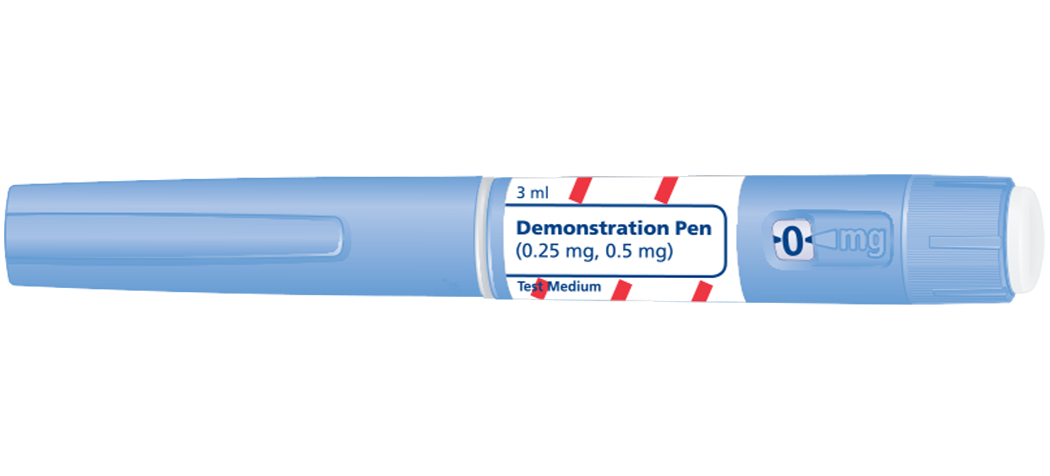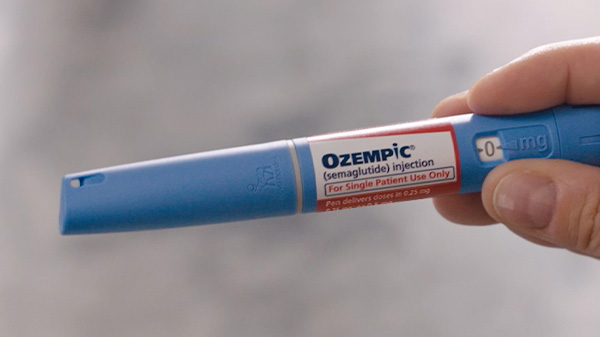Talking to your patients about Ozempic® (semaglutide) injection
Pharmacists, patients may have questions when they pick up their prescription of Ozempic®. Here are some topics you may want to discuss with them.

Actor portrayals.
What is Ozempic®?
Ozempic® is an injectable prescription medicine used:
- For adults with type 2 diabetes, along with diet and exercise, to improve blood sugar (glucose)
- For adults with type 2 diabetes with known heart disease, to reduce the risk of major cardiovascular events such as heart attack, stroke, or death
- For adults with type 2 diabetes and chronic kidney disease, to reduce the risk of kidney disease worsening, kidney failure (end-stage kidney disease), and death due to cardiovascular disease
It is not known if Ozempic® is safe and effective for use in children.
See Section 17: Patient Counseling Information in the Prescribing Information



Pen that delivers
0.25 mg and 0.5 mg only


Pen that delivers
1 mg only

Pen that delivers
2 mg only
aThe starting dose of 0.25 mg is a nontherapeutic dose.
T2D=type 2 diabetes.
Gradual dose escalation to help patients adjust to therapy1
- Administer Ozempic® once weekly on the same day each week, at any time of the day, with or without meals
- The maximum recommended dosage is 2 mg once weekly
- The day of weekly administration can be changed if necessary as long as the time between 2 doses is at least 2 days (>48 hours)
- If a dose is missed, administer Ozempic® as soon as possible within 5 days after the missed dose. If more than 5 days have passed, skip the missed dose and administer the next dose on the regularly scheduled day. In each case, patients can then resume their regular once-weekly dosing schedule
Savings are available for eligible patients
Red Label
Pen that delivers doses of 0.25 mg and 0.5 mg
Contains 2 mg of Ozempic®
Delivers only the starting dose of 0.25 mg and a maintenance dose of 0.5 mg

Includes
x6


Blue Label
Pen that delivers doses of 1 mg
Contains 4 mg of Ozempic®
Delivers only the maintenance dose of 1 mg

Includes
x4


Yellow Label
Pen that delivers doses of 2 mg
Contains 8 mg of Ozempic®
Delivers only the maximum maintenance dose of 2 mg

Includes
x4


Thinnest needle (32G, 4 mm) on a once-weekly GLP-1 RA included with each pen
Order today

How to store the Ozempic® Pen1
Prior to first use
Until expiration date
Refrigerated
36°F to 46°F (2°C to 8°C)
After first use
56 days
Room Temperature
59°F to 86°F (15°C to 30°C)
Refrigerated
36°F to 46°F (2°C to 8°C)
How to dispense Ozempic®1
Ozempic® 0.25 mg or 0.5 mg dose
(2 mg/3 mL subcutaneous pen injector)

NDC: 0169-4181-13
Days supply:
- Sample/initial (42 days)
- 1-month supply (28 days)
Intent of prescription:
- Sample or initial prescription for new starts
- 1-month prescription for maintenance on 0.5 mg
- For patients with T2D and CKD, increase to the recommended maintenance dose of 1 mg after at least 4 weeks on 0.5 mg
Strength: 2 mg per 3 mL (0.68 mg/mL)
Dosage form: Solution
SIG:
- Sample or initial Rx: Inject 0.25 mg SUBQ once weekly for 4 weeks, then 0.5 mg SUBQ once weekly for 2 weeks
- Maintenance Rx: Inject 0.5 mg SUBQ once weekly for 4 weeks
Dispense quantity: 3 mL
Dispense quantity unit of measure: mL ONLY
Needles: 6 included
Number of boxes: 1 box
Ozempic® 0.25 mg or 0.5 mg dose
(2 mg/3 mL subcutaneous pen injector)

NDC: 0169-4181-13
Days supply:
3-month supply (84 days)
Intent of prescription:
- 3-month prescription for maintenance on 0.5 mg
- For patients with T2D and CKD, increase to the recommended maintenance dose of 1 mg after at least 4 weeks on 0.5 mg
Strength: 2 mg per 3 mL (0.68 mg/mL)
Dosage form: Solution
SIG: Maintenance Rx: Inject 0.5 mg SUBQ once weekly for 12 weeks
Dispense quantity: 9 mL
Dispense quantity unit of measure: mL ONLY
Needles: 18 included
Number of boxes: 3 boxes
Ozempic® 1 mg dose
(4 mg/3 mL subcutaneous pen injector)

NDC: 0169-4130-13
Days supply:
- 1-month supply (28 days)
Intent of prescription:
1-month prescription for maintenance on 1 mg
Strength: 4 mg per 3 mL (1.34 mg/mL)
Dosage form: Solution
SIG: Maintenance Rx: Inject 1 mg SUBQ once weekly for 4 weeks
Dispense quantity: 3 mL
Dispense quantity unit of measure: mL ONLY
Needles: 4 included
Number of boxes: 1 box
Ozempic® 1 mg dose
(4 mg/3 mL subcutaneous pen injector)

NDC: 0169-4130-13
Days supply:
3-month supply (84 days)
Intent of prescription:
- 3-month prescription for maintenance on 1 mg
- For patients with T2D and CKD, increase to the recommended maintenance dose of 1 mg
Strength: 4 mg per 3 mL (1.34 mg/mL)
Dosage form: Solution
SIG: Maintenance Rx: Inject 1 mg SUBQ once weekly for 12 weeks
Dispense quantity: 9 mL
Dispense quantity unit of measure: mL ONLY
Needles: 12 included
Number of boxes: 3 boxes
Ozempic® 2 mg dose
(8 mg/3 mL subcutaneous pen injector)

NDC: 0169-4772-12
Days supply:
- 1-month supply (28 days)
Intent of prescription:
- 1-month prescription for maintenance on 2 mg
Strength: 8 mg per 3 mL (2.68 mg/mL)
Dosage form: Solution
SIG: Maintenance Rx: Inject 2 mg SUBQ once weekly for 4 weeks
Dispense quantity: 3 mL
Dispense quantity unit of measure: mL ONLY
Needles: 4 included
Number of boxes: 1 box
Ozempic® 2 mg dose
(8 mg/3 mL subcutaneous pen injector)

NDC: 0169-4772-12
Days supply:
3-month supply (84 days)
Intent of prescription:
3-month prescription for maintenance on 2 mg
Strength: 8 mg per 3 mL (2.68 mg/mL)
Dosage form: Solution
SIG: Maintenance Rx: Inject 2 mg SUBQ once weekly for 12 weeks
Dispense quantity: 9 mL
Dispense quantity unit of measure: mL ONLY
Needles: 12 included
Number of boxes: 3 boxes
CKD=chronic kidney disease.
More ways to help your patients with T2D
Important Safety Information for Ozempic® (semaglutide) injection
WARNING: RISK OF THYROID C-CELL TUMORS
- In rodents, semaglutide causes dose-dependent and treatment-duration-dependent thyroid C-cell tumors at clinically relevant exposures. It is unknown whether Ozempic® causes thyroid C-cell tumors, including medullary thyroid carcinoma (MTC), in humans as human relevance of semaglutide-induced rodent thyroid C-cell tumors has not been determined
- Ozempic® is contraindicated in patients with a personal or family history of MTC and in patients with Multiple Endocrine Neoplasia syndrome type 2 (MEN 2). Counsel patients regarding the potential risk for MTC with the use of Ozempic® and inform them of symptoms of thyroid tumors (eg, a mass in the neck, dysphagia, dyspnea, persistent hoarseness). Routine monitoring of serum calcitonin or using thyroid ultrasound is of uncertain value for early detection of MTC in patients treated with Ozempic®
Indications and Usage
Ozempic® (semaglutide) injection 0.5 mg, 1 mg, or 2 mg is indicated:
- as an adjunct to diet and exercise to improve glycemic control in adults with type 2 diabetes
- to reduce the risk of major adverse cardiovascular (CV) events (CV death, nonfatal myocardial infarction, or nonfatal stroke) in adults with type 2 diabetes and established CV disease
- to reduce the risk of sustained eGFR decline, end-stage kidney disease, and cardiovascular death in adults with type 2 diabetes and chronic kidney disease
Important Safety Information cont.
Contraindications
- Ozempic® is contraindicated in patients with a personal or family history of MTC or in patients with MEN 2, and in patients with a hypersensitivity reaction to semaglutide or to any of the excipients in Ozempic®. Serious hypersensitivity reactions including anaphylaxis and angioedema have been reported with Ozempic®
Warnings and Precautions
- Risk of Thyroid C-Cell Tumors: Patients should be further evaluated if serum calcitonin is measured and found to be elevated or thyroid nodules are noted on physical examination or neck imaging
- Acute Pancreatitis: Acute pancreatitis, including fatal and non-fatal hemorrhagic or necrotizing pancreatitis, has been observed in patients treated with GLP-1 receptor agonists, including semaglutide. Observe patients carefully for signs and symptoms of pancreatitis (persistent severe abdominal pain, sometimes radiating to the back with or without vomiting). If pancreatitis is suspected, discontinue Ozempic® and initiate appropriate management
- Diabetic Retinopathy Complications: In a 2-year trial involving patients with type 2 diabetes and high cardiovascular risk, more events of diabetic retinopathy complications occurred in patients treated with Ozempic® (3.0%) compared with placebo (1.8%). The absolute risk increase for diabetic retinopathy complications was larger among patients with a history of diabetic retinopathy at baseline than among patients without a known history of diabetic retinopathy.
Rapid improvement in glucose control has been associated with a temporary worsening of diabetic retinopathy. The effect of long-term glycemic control with semaglutide on diabetic retinopathy complications has not been studied. Patients with a history of diabetic retinopathy should be monitored for progression of diabetic retinopathy - Never Share an Ozempic® Pen Between Patients: Ozempic® pens must never be shared between patients, even if the needle is changed. Pen-sharing poses a risk for transmission of blood-borne pathogens
- Hypoglycemia: Patients receiving Ozempic® in combination with an insulin secretagogue (e.g., sulfonylurea) or insulin may have an increased risk of hypoglycemia, including severe hypoglycemia. Inform patients using these concomitant medications of the risk of hypoglycemia and educate them on the signs and symptoms of hypoglycemia
- Acute Kidney Injury Due to Volume Depletion: There have been postmarketing reports of acute kidney injury, in some cases requiring hemodialysis, in patients treated with semaglutide. The majority of reported events occurred in patients who experienced gastrointestinal reactions leading to dehydration such as nausea, vomiting, or diarrhea. Monitor renal function in patients reporting adverse reactions to Ozempic® that could lead to volume depletion, especially during dosage initiation and escalation
- Severe Gastrointestinal Adverse Reactions: Use of Ozempic® has been associated with gastrointestinal adverse reactions, sometimes severe. In Ozempic® clinical trials, severe gastrointestinal adverse reactions were reported more frequently among patients receiving Ozempic® (0.5 mg 0.4%, 1 mg 0.8%) than placebo (0%). Ozempic® is not recommended in patients with severe gastroparesis
- Hypersensitivity: Serious hypersensitivity reactions (e.g., anaphylaxis, angioedema) have been reported in patients treated with Ozempic®. If hypersensitivity reactions occur, discontinue use of Ozempic®; treat promptly per standard of care, and monitor until signs and symptoms resolve. Use caution in a patient with a history of angioedema or anaphylaxis with another GLP-1 receptor agonist
- Acute Gallbladder Disease: Acute events of gallbladder disease such as cholelithiasis or cholecystitis have been reported in GLP-1 receptor agonist trials and postmarketing. In placebo-controlled trials, cholelithiasis was reported in 1.5% and 0.4% of patients treated with Ozempic® 0.5 mg and 1 mg, respectively, and not reported in placebo-treated patients. If cholelithiasis is suspected, gallbladder studies and appropriate clinical follow-up are indicated
- Pulmonary Aspiration During General Anesthesia or Deep Sedation: Ozempic® delays gastric emptying. There have been rare postmarketing reports of pulmonary aspiration in patients receiving GLP-1 receptor agonists undergoing elective surgeries or procedures requiring general anesthesia or deep sedation who had residual gastric contents despite reported adherence to preoperative fasting recommendations. Instruct patients to inform healthcare providers prior to any planned surgeries or procedures if they are taking Ozempic®
Adverse Reactions
- The most common adverse reactions, reported in ≥5% of patients treated with Ozempic® are nausea, vomiting, diarrhea, abdominal pain, and constipation
Drug Interactions
- When initiating Ozempic®, consider reducing the dose of concomitantly administered insulin secretagogue (such as sulfonylureas) or insulin to reduce the risk of hypoglycemia
- Ozempic® causes a delay of gastric emptying and has the potential to impact the absorption of concomitantly administered oral medications, so caution should be exercised
Use in Specific Populations
- There are limited data with semaglutide use in pregnant women to inform a drug-associated risk for adverse developmental outcomes. Discontinue Ozempic® in women at least 2 months before a planned pregnancy due to the long washout period for semaglutide
Please click here for Ozempic® Prescribing Information, including Boxed Warning.
Reference:
- Ozempic® [package insert]. Plainsboro, NJ: Novo Nordisk Inc.
